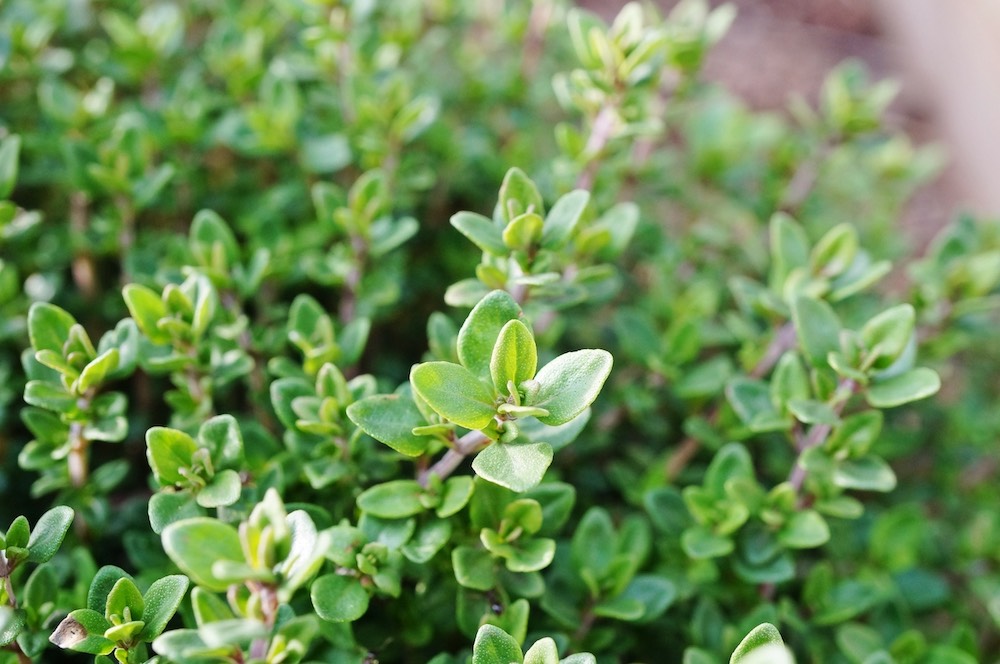Thyme

The fragrant thyme plant (Thymus vulgaris) has a long history as a healing herb for treating humans and animals and is still considered a valuable medicinal plant for respiratory complaints. Its beneficial effects also extend to aiding digestive ailments.
Where thyme is found?
Thyme plants can grow 20 to 40 cm in height and prefer hot, dry, sunny spots with limey soil. This unpretentious cooking herb is common in many varieties throughout Central and Southern Europe. Common thyme (Thymus vulgaris) is also known as German thyme, garden thyme, or simply as thyme, and was officially named Medicinal Plant of the Year in 2006.
On the historical significance of thyme
The name for thyme comes from the Greek thymiana – the word for the incense offered up to the gods in ancient temples, and surely associated with the intense fragrance of the thyme herb. In 1100 C.E., monks from the Mediterranean regions brought the plant known as herba thymiana over the Alps, where it became prized for its culinary and medicinal uses. In the 12th century, Hildegard von Bingen recommended thyme as the herb of choice for treating whooping cough.
"Drinking thyme cooked with honey is beneficial and useful to those who wheeze and have difficulty breathing." Leonhart Fuchs, physician and botanist, "Das Kräuterbuch von 1543"
Thyme as a healing herb
Whole thyme leaves and flowers stripped from the stems are often used to make tea. Syrups, tinctures, and fluid or dry extracts, which are easier to administer, have proven particularly effective.
The combination of thyme with fennel, sage, liquorice, and anise allows for a greater range of effects in treating respiratory ailments.
Thyme's main active substances
Thyme leaf contains a number of essential oils, particularly thymol and carvacrol as well as tanning agents and flavonoids.
The essential oil thymol provides thyme with its characteristic scent. It is quickly absorbed by the organism and digested in the stomach and intestines. Thymol has disinfectant, antioxidant, anti-inflammatory, anti-microbial, anti-viral and immunomodulatory properties.
Carvacrol is a plant substance similar to thymol but less frequently occurring. Mainly found in Mediterranean plants as a component of essential oils, this substance has antioxidant, pain-relieving and warming effects. It can also inhibit the growth of various types of bacteria such as Escherichia coli and Staphylococcus aureus by destroying the cell membranes of these bacteria. In combination with thymol, carvacrol has anti-inflammatory and anti-fungal effects.
Thyme contains luteolin, a flavonoid described as antioxidant and anti-inflammatory and which boosts the immune system.
Did you know?
Thyme has an ORAC (Oxygen Radical Absorption Capacity) value of over 27,000. This suggests enormous antioxidant potential. In comparison: the ORAC values for fresh fruits often lie below 5,000! The antioxidant effects of the plant extracts are likely based on the radical bonding properties of various elements of the essential oils.
The uses of thyme
Thyme preparations are used for a variety of purposes but primarily to treat coughs.
Thyme supports the airways
Thyme's expectorant and anti-spasmodic properties as well as its anti-microbial effects help to treat ailments like dry coughs and bronchitis. Thyme leaf extracts relieve coughing and stimulate activity in the cilia of the mucous membranes and help to remove mucous lodged in the airways. Thymol's disinfecting and immunomodulatory effects can shorten the duration of illness.
Thyme supports digestion
The reason why thyme leaf is a popular culinary seasoning is not only due to its aroma: its benefits for digestion have long been known. Thyme has anti-spasmodic properties which help to relax smooth intestinal muscle. Thyme's digestive properties also support the organism in cases of liver function disorders. The plant's essential oils stimulate the excretion of bile and enzymes and have immunomodulatory and anti-bacterial effects in the intestines, inhibiting the growth of pathogenic germs without affecting healthy intestinal flora.
Side effects
An overdose of thymol can irritate the mucous membranes and lead to diarrhoea and vomiting. There are no known side effects for ingesting normal amounts.
Caution: Do not administer to animals with gastroenteritis or nephritis or to pregnant animals!
Sources and further reading
- Purle, T. (09. 01 2020). Kräuterbuch.de. Von Thymian: https://www.kraeuter-buch.de/kraeuter/Thymian.html abgerufen
- Reichling, J., Gachnian-Mirtscheva, R., Frater-Schröder, M., Di Carlo, A., & Widmaier, W. (2008). Heilpflanzenkunde für die Veterinärpraxis. Berlin-Heidelberg: Springer Medizin Verlag.
- Thieme. (16. 01 2006). Von Thymian als Arzneipflanze: https://m.thieme.de/viamedici/aktuelles-medizin-und-wissenschaft-1650/a/thymian-als-arzneipflanze-5297.htm abgerufen













